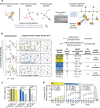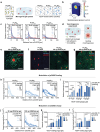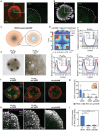Microgels With Electrostatically Controlled Molecular Affinity to Direct Morphogenesis
- PMID: 39449199
- PMCID: PMC11756038
- DOI: 10.1002/adma.202409731
Microgels With Electrostatically Controlled Molecular Affinity to Direct Morphogenesis
Abstract
Concentration gradients of soluble signaling molecules-morphogens-determine the cellular organization in tissue development. Morphogen-releasing microgels have shown potential to recapitulate this principle in engineered tissue constructs, however, with limited control over the molecular cues in space and time. Inspired by the functionality of sulfated glycosaminoglycans (sGAGs) in morphogen signaling in vivo, a library of sGAG-based microgels is developed and designated as µGel Units to Instruct Development (µGUIDEs). Adjustment of the microgel's sGAG sulfation patterns and concentration enabled the programming of electrostatic affinities that control the release of morphogens. Based on computational analyses of molecular transport processes, µGUIDEs provided unprecedented precision in the spatiotemporal modulation of vascular endothelial growth factor (VEGF) gradients in a microgel-in-gel vasculogenesis model and kidney organoid cultures. The versatile approach offers new options for creating morphogen signaling centers to advance the understanding of tissue and organ development.
Keywords: VEGF; artificial signaling centers; beads; heparin; kidney organoids; microgels; morphogen gradients; sulfated glycosaminoglycans; vascular morphogenesis.
© 2024 The Author(s). Advanced Materials published by Wiley‐VCH GmbH.
Conflict of interest statement
U.F. and C.W. are co‐inventors of a patent (WO2010060485A1) covering the hydrogel materials used in this study. They also hold shares in the spin‐off company ZetaScience GmbH, Dresden, offering customized hydrogel precursors.
Figures



Similar articles
-
Bioengineering tissue morphogenesis and function in human neural organoids.Semin Cell Dev Biol. 2021 Mar;111:52-59. doi: 10.1016/j.semcdb.2020.05.025. Epub 2020 Jun 12. Semin Cell Dev Biol. 2021. PMID: 32540123 Free PMC article. Review.
-
The case for applying tissue engineering methodologies to instruct human organoid morphogenesis.Acta Biomater. 2017 May;54:35-44. doi: 10.1016/j.actbio.2017.03.023. Epub 2017 Mar 16. Acta Biomater. 2017. PMID: 28315813 Free PMC article. Review.
-
Dual Action of Sulfated Hyaluronan on Angiogenic Processes in Relation to Vascular Endothelial Growth Factor-A.Sci Rep. 2019 Dec 2;9(1):18143. doi: 10.1038/s41598-019-54211-0. Sci Rep. 2019. PMID: 31792253 Free PMC article.
-
Engineering de novo assembly of fetal pulmonary organoids.Tissue Eng Part A. 2014 Nov;20(21-22):2892-907. doi: 10.1089/ten.TEA.2014.0085. Epub 2014 Jun 25. Tissue Eng Part A. 2014. PMID: 24825442 Free PMC article.
-
Bioprinting of Aptamer-Based Programmable Bioinks to Modulate Multiscale Microvascular Morphogenesis in 4D.Adv Healthc Mater. 2025 Jan;14(1):e2402302. doi: 10.1002/adhm.202402302. Epub 2024 Nov 1. Adv Healthc Mater. 2025. PMID: 39487611 Free PMC article.
References
MeSH terms
Substances
Grants and funding
LinkOut - more resources
Full Text Sources

